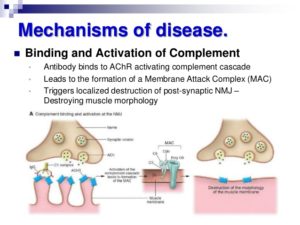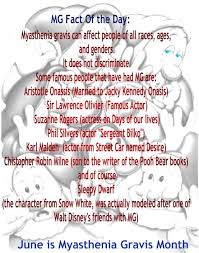What is Myasthenia Gravis?
Myasthenia gravis is an autoimmune disease. Your body’s own immune system makes antibodies that block or change some of the nerve signals to your muscles. This makes your muscles weaker.
This neuromuscular disease leads to fluctuating muscle weakness and fatigue. Getting in more technical terminology in the most common cases, muscle weakness is caused by circulating antibodies that block nicotinic acetylcholine receptors at the postsynaptic neuromuscular junction. By blocking the ability of the neurotransmitter acetylcholine to bind to these receptors in the muscle, these antibodies keep motor neurons from signaling the muscle to contract (to do movement). Alternatively, in a much rarer form, muscle weakness is caused by a genetic defect in some portion of the neuromuscular junction that is inherited at birth as opposed to developing through passive transmission from the mother’s immune system at birth or through autoimmunity later in life.
Common symptoms are trouble with eye and eyelid movement, facial expression and swallowing. But it can also affect other muscles. The weakness gets worse with activity, and better with rest.
There are medicines to help improve nerve-to-muscle messages and make muscles stronger. With treatment, the muscle weakness often gets much better. Other drugs keep your body from making so many abnormal antibodies. There are also treatments which filter abnormal antibodies from the blood or add healthy antibodies from donated blood. Sometimes surgery to take out the thymus gland helps.
For some people, myasthenia gravis can go into remission and they do not need medicines. The remission can be temporary or permanent.
If you have myasthenia gravis, it is important to follow your treatment plan. If you do, you can expect your life to be normal or close to it.
Common signs or symptoms of the disease are:
Painless, worsening muscle weakness usually seen at the end of the day or after exercise
Blurred or double vision
Drooping eyelids and facial muscles
Slurred speech
Fast heartbeats
Shortness of breath or trouble breathing
How it is diagnosed:
During a physical exam, your health care provider may observe signs such as a droopy eyelid, difficulty holding your arms out at shoulder length for a reasonable length of time, or a weak grasp.
Blood tests may reveal the presence of acetylcholine-receptor or muscle-specific tyrosine kinase-seropositive (MuSK) antibodies. Specialized tests use electricity to stimulate muscles, and at the same time, measure the strength of muscle contraction.
If you have myasthenia gravis, muscle strength will decrease predictably over the course of testing. You may be given certain medications — edrophonium or neostigmine — as part of a diagnostic exam. In a patient with myasthenia gravis, these drugs will significantly and noticeably improve muscle strength for a short time. This helps to further confirm the diagnosis.
Recommended Related to Brain & Nervous System
Rapid-onset Obesity with Hypothalamic Dysfunction, Hypoventilation, and Autonomic Dysregulation
Important It is possible that the main title of the report Rapid-onset Obesity with Hypothalamic Dysfunction, Hypoventilation, and Autonomic Dysregulation is not the name you expected. Please check the synonyms listing to find the alternate name(s) and disorder subdivision(s) covered by this report.
Because other conditions sometimes occur along with myasthenia gravis and can interfere with treatment, your health care provider may order other tests. You may need a CT scan or an MRI to check for a thymoma. You’ll be checked for high blood pressure and glaucoma, and you’ll probably have your blood tested to see if you have thyroid disease, other autoimmune diseases (such as rheumatoid arthritis or systemic lupus erythematosus), diabetes, kidney problems, or any infections.
What Are the Treatments for Myasthenia Gravis?
There is no cure for myasthenia gravis, but it is treated with medications and sometimes surgery. You may be put on a drug called pyridostigmine (Mestinon), that increases the amount of acetylcholine available to stimulate the receptors.
The disorder is most commonly treated with the steroid prednisone and the the drugs azathioprine (Imuran), mycophenolate (CellCept), and cyclosporine (Neoral) to suppress the immune system.
In severe cases, you may need to have your blood sent through a special machine that removes the antibody-containing plasma and replaces it with antibody-free plasma. This is called plasmapheresis. You may also be given a preparation called intravenous immunoglobulin (IVIg) through a needle in a vein.
If you have a thymoma, you will need surgery to remove your thymus (thymectomy). In fact, your doctor may recommend that you undergo this surgery even if no tumor is present because removal of the thymus seems to improve symptoms in many patients.
Research continues on and even T cells being looked at for putting the patient back in remission which has been reached in research labs on mice and other animals. Technology and medical research are a step away from knowing how to put a patient in remission for a long time if not forever. Hopefully its around the corner and history keep showing cure for one disease after another. We do have hope in that this disease will be under complete control one day.

